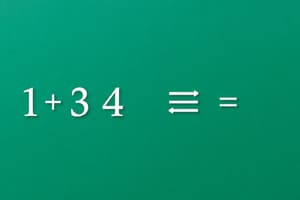Podcast
Questions and Answers
What is the property of an operation and a set that guarantees performing the operation on members of the set yields a member of the set?
What is the property of an operation and a set that guarantees performing the operation on members of the set yields a member of the set?
- Commutative Property
- Distributive Property
- Identity Property
- Closure (correct)
What set of numbers is designated with Z?
What set of numbers is designated with Z?
Integers
What type of numbers cannot be written as the ratio of two integers?
What type of numbers cannot be written as the ratio of two integers?
Irrational numbers
What is the set of natural numbers designated with?
What is the set of natural numbers designated with?
What is the definition of rational numbers?
What is the definition of rational numbers?
What does the set of real numbers include?
What does the set of real numbers include?
What set of numbers includes {0, 1, 2, 3,...}?
What set of numbers includes {0, 1, 2, 3,...}?
What is the symbol for union in set notation?
What is the symbol for union in set notation?
What does the symbol ∈ represent?
What does the symbol ∈ represent?
What does the symbol ∉ represent?
What does the symbol ∉ represent?
What does the symbol ⊂ indicate?
What does the symbol ⊂ indicate?
Natural numbers are closed under addition and multiplication but not under subtraction or division.
Natural numbers are closed under addition and multiplication but not under subtraction or division.
Real numbers are closed under addition, subtraction, multiplication, and division.
Real numbers are closed under addition, subtraction, multiplication, and division.
What is the additive identity element?
What is the additive identity element?
What is the Additive Inverse Property?
What is the Additive Inverse Property?
What does the Associative Property of Addition state?
What does the Associative Property of Addition state?
What does the Commutative Property of Multiplication state?
What does the Commutative Property of Multiplication state?
For any numbers a, b, and c, what does the Distributive Property of Multiplication over Addition state?
For any numbers a, b, and c, what does the Distributive Property of Multiplication over Addition state?
What is the multiplicative identity element?
What is the multiplicative identity element?
What is the expression for the discriminant?
What is the expression for the discriminant?
What is a quadratic equation?
What is a quadratic equation?
What is the definition of a binomial?
What is the definition of a binomial?
What is a linear equation?
What is a linear equation?
The property that states for any numbers a and b, if a = b, then b = a is known as the ______.
The property that states for any numbers a and b, if a = b, then b = a is known as the ______.
What is the Trichotomy Property?
What is the Trichotomy Property?
What is a polynomial?
What is a polynomial?
What is the definition of a monomial?
What is the definition of a monomial?
What is a trinomial?
What is a trinomial?
Flashcards
Closure Property
Closure Property
A set is closed if performing an operation on its members always results in a member of the same set.
Integers (Z)
Integers (Z)
The set of numbers including zero, positive integers, and negative integers.
Irrational Numbers
Irrational Numbers
Real numbers that cannot be expressed as a ratio of two integers.
Natural Numbers (N)
Natural Numbers (N)
Signup and view all the flashcards
Rational Numbers (Q)
Rational Numbers (Q)
Signup and view all the flashcards
Real Numbers (R)
Real Numbers (R)
Signup and view all the flashcards
Whole Numbers
Whole Numbers
Signup and view all the flashcards
Union (∪)
Union (∪)
Signup and view all the flashcards
Member of (∈)
Member of (∈)
Signup and view all the flashcards
Not a Member of (∉)
Not a Member of (∉)
Signup and view all the flashcards
Subset of (⊂)
Subset of (⊂)
Signup and view all the flashcards
Closure of Natural Numbers
Closure of Natural Numbers
Signup and view all the flashcards
Closure of Real and Rational Numbers
Closure of Real and Rational Numbers
Signup and view all the flashcards
Additive Identity Element
Additive Identity Element
Signup and view all the flashcards
Additive Inverse Property
Additive Inverse Property
Signup and view all the flashcards
Associative Property of Addition
Associative Property of Addition
Signup and view all the flashcards
Associative Property of Multiplication
Associative Property of Multiplication
Signup and view all the flashcards
Commutative Property of Addition
Commutative Property of Addition
Signup and view all the flashcards
Commutative Property of Multiplication
Commutative Property of Multiplication
Signup and view all the flashcards
Distributive Property
Distributive Property
Signup and view all the flashcards
Multiplicative Identity Element
Multiplicative Identity Element
Signup and view all the flashcards
Multiplicative Inverse Property
Multiplicative Inverse Property
Signup and view all the flashcards
Reflexive Property
Reflexive Property
Signup and view all the flashcards
Symmetric Property
Symmetric Property
Signup and view all the flashcards
Transitive Property
Transitive Property
Signup and view all the flashcards
Trichotomy Property
Trichotomy Property
Signup and view all the flashcards
Binomial
Binomial
Signup and view all the flashcards
Monomial
Monomial
Signup and view all the flashcards
Study Notes
Fundamental Concepts in Algebra II
-
Closure: Property of a set that ensures performing an operation on its members always results in a member of the same set.
-
Integers (Z): Include numbers {0, +1, −1, +2, −2,...}.
-
Irrational Numbers: Real numbers that cannot be represented as a ratio of two integers, denoted as ǭ.
-
Natural Numbers (N): Consist of positive integers {1, 2, 3, 4,...}.
-
Rational Numbers (Q): Numbers expressed as a fraction a/b where a and b are integers and b ≠ 0.
-
Real Numbers (R): Combination of rational and irrational numbers.
-
Whole Numbers: Include non-negative integers {0, 1, 2, 3,...}.
Set Notation and Membership
-
Union (∪): Combines two sets to include all unique elements from both.
-
Member of (∈): Indicates if an element belongs to a set.
-
Not a Member of (∉): Indicates if an element does not belong to a set.
-
Subset of (⊂): A set where all its elements are contained within another set.
Properties of Number Sets
-
Natural Numbers: Closed under addition and multiplication but not under subtraction or division.
-
Real and Rational Numbers: Closed under addition, subtraction, multiplication, and division (excluding division by 0).
Key Mathematical Properties
-
Additive Identity Element: 0 acts as the identity since a + 0 = a for any number a.
-
Additive Inverse Property: Every number a has an inverse (−a) such that a + (−a) = 0.
-
Associative Property of Addition: (a + b) + c = a + (b + c) for any numbers a, b, and c.
-
Associative Property of Multiplication: (a⋅b)⋅c = a⋅(b⋅c) for any numbers a, b, and c.
-
Commutative Property of Addition: a + b = b + a.
-
Commutative Property of Multiplication: a⋅b = b⋅a.
-
Distributive Property: a(b + c) = ab + ac for any numbers a, b, and c.
-
Multiplicative Identity Element: 1 acts as the identity since a⋅1 = a.
-
Multiplicative Inverse Property: For any number a ≠ 0, there exists an inverse (1/a) such that a⋅(1/a) = 1.
Properties of Equality
-
Reflexive Property: a = a for any number a.
-
Symmetric Property: If a = b, then b = a.
-
Transitive Property: If a = b and b = c, then a = c.
-
Trichotomy Property: For any numbers, either a < b, a = b, or a > b.
Polynomial Concepts
-
Binomial: A polynomial with two terms.
-
Monomial: A polynomial with one term.
-
Polynomial: A mathematical expression containing constants and variables using addition and multiplication.
-
Term: A constant, variable, or the product of a constant and variables.
-
Trinomial: A polynomial with three terms.
Equations and Inequalities
-
Linear Equation: An equation in which each term is constant or the product of a constant and a single variable.
-
Linear Inequality: Similar to linear equations, it involves constants or the product of constants and a variable but indicates a range instead of an exact value.
Additional Concepts
-
Substitution Property of Equality: If x = y, y can replace x in an expression.
-
Graph: A visual representation showing relationships among numbers.
-
Discriminant: The expression b² - 4ac which determines the nature of roots in quadratic equations.
-
Quadratic Equation: Form ax² + bx + c = y, where a, b, c are real numbers and a ≠ 0.
-
Quadratic Formula: Formula to find the roots of a quadratic equation.
Studying That Suits You
Use AI to generate personalized quizzes and flashcards to suit your learning preferences.




